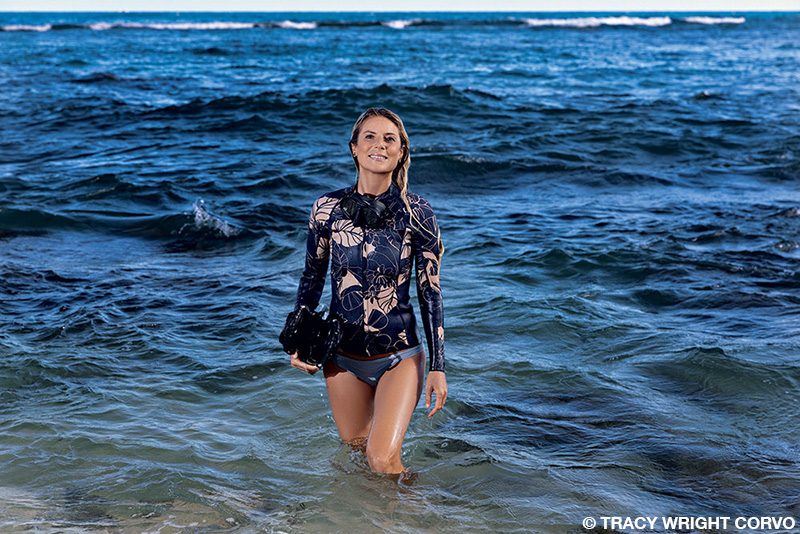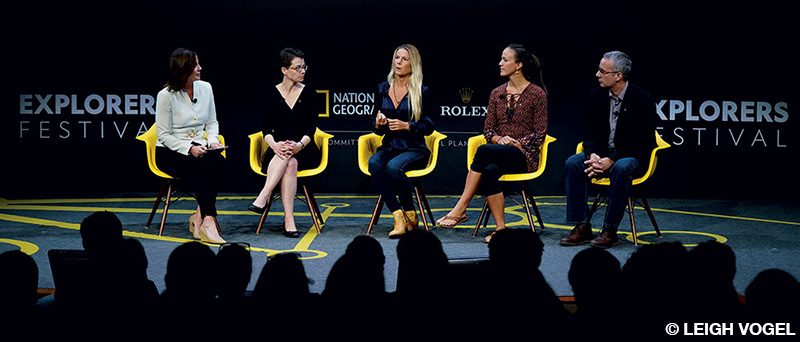Hometown: I grew up in Great Barrington, Massachusetts, and now live and work in Haleiwa, Hawaii.
Years Diving: About 20 years
Favorite Dive Destination: Galápagos Islands
Why I’m a DAN® Member: Community, knowledge, inspiration, peace of mind
While always enthralled with the ocean, ocean ecologist Jonatha Giddens, Ph.D., had no interest in pursuing science when she was a child. In her young mind, scientists “worked at sterile lab benches with pieces of dead specimens.” Art, however, has been her passion since she was young. While growing up, Giddens used art for fun, learning and even therapy. Now art is deeply integrated into her science.
While attending the University of Hawaii, Hilo, she began to see science in a new light and learned that not all scientists wear lab coats. Giddens realized there is a “whole community of explorers like me, who love nature and want to do everything they can to help us live in balance with the natural world.” As a fellow with National Geographic Society Labs, she currently works within this community, exploring deep ocean ecosystems.
Science may not have been an immediate passion for Giddens as a child, but the ocean most certainly was. Growing up inland in Massachusetts, Giddens fondly remembers her weeklong family vacations on the coast. After she finished high school, she knew she needed to move closer to the sea. She worked as a captain and dive instructor before sailing on a tall ship when she enrolled in the Semester at Sea program, which took her to Hilo, Hawaii. There she stayed and began her studies at the University of Hawaii.

“I chose marine science as a major because I wanted to learn everything that I could about the ocean so I could be in the best position to help,” Giddens said. “I still didn’t see myself as a scientist, but I put that self-imposed limit aside because marine scientists were doing the conservation and education work that I wanted to do.”
The deep ocean fascinates Giddens: She speaks enthusiastically about the creatures with amazing adaptations that live at the bottom of the sea such as the sixgill shark and a fish called a barreleye (Macropinna microstoma), which has a transparent head and tubular eyes that point upward and can rotate forward in its head. Her perspective as a scientist reaches beyond the depths.
“My career goal is to help safeguard ocean ecosystems and galvanize a transformation where human culture is in balance with nature,” she explained. “I want to amplify the wonder and beauty of the ocean and change the world that way.”

With her unique viewpoint, Giddens uses unique methodology. Art, journaling and storytelling are key components to her scientific endeavors.
“I keep a field journal and use drawing for observation,” she said. “It puts me in a state where I am receptive to fresh ideas, ways of seeing wholeness that my intellectual life would not otherwise be able to grasp.… I still take samples and run statistical models, but these pictures, words and poems show another dimension of the place — one that comes from a heart space and reaches to the feeling of people so they can see the beauty and care to protect it, too. By integrating art and stories with science and technology, we can break new ground in connecting people with ocean places to better understand and care for our planet.
“An artistic approach can help us to establish our human connection with the natural world — our place in it.”
The human connection to the deep sea is greater than you may imagine. “Discoveries in the deep sea have changed our understanding of how life may have originated and the extreme conditions in which it can thrive,” Giddens explained. “The deep sea holds clues to our human history and our movement across the globe — think of all the shipwrecks. The physical and biological processes within the oceans are critical to supporting all life on Earth.”

These discoveries are only the beginning. “We know so little about the deep sea,” Giddens said. “It is estimated that only 0.0001 percent has been scientifically explored. The deep ocean is the largest yet least understood ecosystem on the planet. It really is the final frontier of earth science.”
Fortunately, explorers like Giddens are excited to learn more about this “final frontier.” As a child at the beach she would swim straight out and pretend she was floating in the middle of the ocean. “When I started diving,” she said, “I would always head straight to the drop-off and gaze down into the darkness, wanting to keep going to see what’s down there and be immersed in it.”
Her current work involves collecting video footage from deepwater habitats around the world. She uses the footage to compute biodiversity indices, which “help us further understand how geography, ocean chemistry and geology affect deep ocean biodiversity and in turn how humans are impacting the deep ocean,” she said. It’s important to learn where the biodiversity hotspots are so management and protection efforts can be focused accordingly. Researchers estimate that the deep sea contains about 90 percent of all life.
While Giddens uses top-of-the-line camera technology (the Exploration Technology Lab’s Deep Ocean Dropcam) to collect her footage , she also sketches the animals that appear in the videos. “An artist can capture character — the creatures come to life through the artists,” she explains. “Drawing is a process of intense observation, a seeing that is enhanced beyond just glancing at a video. I draw in part to understand the creatures that I am seeing. Through their form I understand more about their life and gesture. I can also capture and portray more of what I want to show of the creature. Sometimes videos don’t capture the whole thing, just parts. An artist can take all the video clips together to make a complete picture and enhance parts that are not easily seen in a video with dim lighting, such as the movement of water around the tail.”

Despite Giddens’ busy life, she feels it is important for her to take time for education and outreach. In high school she was inspired by the famous deep-sea explorer Robert Ballard and wants to “pass on that spark of inspiration that he gave me.” Perhaps Giddens and her unique scientific perspective will motivate the next young explorer.
If nothing else, the next generation will recognize that not all scientists wear lab coats. Some are in a submersible at the bottom of the ocean with an art pad, sketching never-before-seen creatures to learn how to better connect humans and nature.
Explore More
Learn more about Jonatha Giddens’ work in these videos.
© Alert Diver — Q4 2019